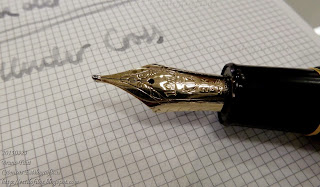The
National Museum of Japanese History, in the city of Sakura (Chiba prefecture), hosts these days –March 8th to May 8th 2016—an exhibition on fountain pens:
“Fountain Pens: Their History ad Art in Japan”. That is the official English title. However, the original in Japanese is more along the lines of “Lifestyle and Fountain Pens. The Modernization of Writing”.
Finally I had the chance to attend it and these are my recollections:
Sakura is a small town (population around 180000) in the prefecture of Chiba, about 60 minutes away from Tokyo Station by train. The Museum is connected to the train station by a bus route that takes 15 min. The admission fee to the exhibition is JPY 830. No pictures are allowed.
This is the outline:
Lifestyle and Fountain Pens. The Modernization of Writing.
0. Introduction. Literature and writing in Japan.
1. Fountain pens in Japan and their craftsmanship.
1.1 History of fountain pens in Japan.
1.2 Craftsmanship.
-- Lathe masters.
--
Maki-e.
2. Fountain pens and contemporary Japan.
2.1 The time of fountain pens.
2.2 Fountain pens and the modern organization.
2.3 Fountain pens and daily life.
3. Epilogue. Writing revisited.
The starting point of the exhibition is the role fountain pens played around 1900 in Japan. Fountain pens –that is, a reliable writing tool with an integrated ink deposit—were a much better writing device in a highly literate society whose writing system was based on handwriting. This starting point, somehow, defines the whole exhibition whose focus is on the social influence of pens and not on the historical development of them.
In fact, as could be seen on the outline, the part dedicated to the history of pen in Japan is limited to the first section (1.1). It is, however, rather limited and is organized by brands, with the big three companies taking most of the available space. A more chronological display would have been a lot more illustrative. There is also the obvious void of pens made after 1980 (save for some
contemporary Pilot Capless and some
Kato Seisakusho’s models).
Given the focus of the exhibition, most of the pens on display are common tools that were available to the average citizen. The most obvious exception to this rule is the selection of
maki-e decorated pens used to illustrate the section on Japanese craftsmanship.
This section is completed with assorted memorabilia: ads, display cases, sale materials, etc.
More importance is given to the theme of craftsmanship of pens (section 1.2), focused on two aspects: pen turning and
maki-e decoration.
Pen turning by rather primitive means has always been an important part of the Japanese pen industry. Let us remember brands as
Ban-ei,
Kato Seisakusho, Hakase,
Eboya, Ohashido, and many others. Several of those lathes --pedal operated, with precarious chucks more often than not, and unstable toolposts— together with sets of tools can be seen at the museum.
Maki-e is also very well presented. The selection of pens, many from private collections, is magnificent and is supported by a computer system where visitors can explore the decorative motifs in detail through high quality pictures.
The exhibition is interesting and worth the trip from Tokyo. After all, pens rarely show up collectively in museums. Unfortunately, pictures are not allowed. However, there is a very serious flaw: pens and other objects are not dated. This is an inexplicable mistake to any curator.
The catalog is nicely printed and is affordable in price (JPY 1800, plus tax). Pictures, and in particular those of
maki-e pens, are very good. But the editor made a big mistake. There are a number of pictures of pens that are seamless compositions of pictures of single pens. At the time of putting them together, someone made the stupid decision of representing all the pens in the same length, not respecting the actual differences in size. The result is ridiculous: a pocket pen of the same length of a full size Pilot Custom Sterling, as can be seen on the accompanying pictures.
 Page 30 of the catalog shows these six Pilot pens. All of them, apparently, have the same length.
Page 30 of the catalog shows these six Pilot pens. All of them, apparently, have the same length.
 This is how those six pens (save minor decorative details) really look like with respect to each other. This ridiculous mistake is repeated in a number of pages of the catalog.
This is how those six pens (save minor decorative details) really look like with respect to each other. This ridiculous mistake is repeated in a number of pages of the catalog.
The lack of dates in the exhibition is not corrected in the catalog. Again, we are deprived of that valuable piece of information.
But I would visit the exhibition “Lifestyle and Fountain Pens” again.
My thanks to Poplicola-san.
Ban-ei in black urushi – Pilot Blue
Bruno Taut
Nakano, April 20th 2016
etiquetas: evento, Japón, estilofilia




























































